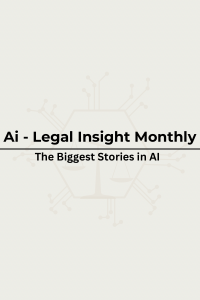Welcome to the AI-Legal Insight Monthly News Roundup!
Each month, we bring you the biggest AI and legal developments – tech breakthroughs, regulatory battles, and everything in between.
From boardroom bombshells to groundbreaking tech debuts, this month has been a whirlwind in the world of artificial intelligence. AI isn’t just evolving—it’s redefining industries, job markets, and even the devices we use to interact with the world. Whether you’re a legal eagle, tech enthusiast, or just trying to keep up with the latest digital drama, we’ve got you covered. Here are the top 5 AI stories from May 2025 that everyone’s talking about—and why they matter.
Disclaimer: The links provided on this blog lead to external websites that are not under my control. I do not guarantee the accuracy, or the content of those sites. Visiting these sites is at your own discretion and risk.
1. Anthropic CEO: “AI Could Wipe Out Half of Entry-Level White-Collar Jobs”
In a bold (and slightly terrifying) statement, Anthropic CEO Dario Amodei warned that AI could eliminate up to 50% of entry-level white-collar jobs in the next five years. Think law, finance, consulting, and tech—basically, all the jobs fresh graduates dream of. He called for more honesty from governments and corporations about the disruption AI will bring. While AI might save costs and boost innovation, Amodei made it clear: we need safety nets and retraining programs, or risk a spike in unemployment that could hit 20%. Consider this your nudge to future-proof your skills—and your CV.
Amodei’s comments stand out in a tech industry that often prefers to spotlight AI’s potential rather than its pitfalls. His remarks also reignited debate around the ethical responsibilities of AI developers and whether they should be required to mitigate the social consequences of their creations. Critics argue that while AI boosts productivity, the gains are not being evenly distributed—leaving displaced workers with few transition options. On the flip side, optimists believe AI will also create new roles in governance, data ethics, and interdisciplinary collaboration. Still, the speed of disruption may outpace society’s ability to adapt unless policies catch up—and fast.
2. Google Drops Veo 3: The AI Video Generator Changing the Game
Google used its annual I/O conference to unveil Veo 3, a next-level video generation tool that creates cinematic-quality videos from simple text prompts—with synchronized audio and all the bells and whistles. It’s like having a Hollywood studio in your laptop. Veo 3 doesn’t just make pretty videos; it raises critical questions about creative jobs, intellectual property, and misinformation. While some creators are thrilled about the democratization of content creation, others fear a flood of AI-generated noise. The tech is thrilling—yes—but the legal and ethical implications? Buckle up, lawyers.
What sets Veo 3 apart is its ability to understand nuanced prompts and render realistic physics, gestures, and environments, pushing the limits of what generative media can achieve. Google has already begun partnering with selected creators and filmmakers to explore ethical and artistic use cases—but mass adoption is just around the corner. With subscription tiers already live in the U.S., including one that offers native audio generation, the platform could soon reshape how brands, influencers, and even legal educators produce visual content. As always, the challenge lies not just in what the technology can do, but in how we choose to use—and regulate—it.
3. OpenAI + Jony Ive = The iPhone Moment for AI?
In what could be described as AI’s Apple moment, OpenAI acquired “LoveFrom,” the hardware studio of ex-Apple design legend Jony Ive. Their mission? To build a revolutionary AI-first device that ditches screens for more intuitive interfaces—think voice, gesture, or who-knows-what. This $6.4 billion deal is about more than aesthetics; it marks OpenAI’s move into consumer hardware. While details are scarce, the merger suggests a future where AI isn’t just software but a tangible part of our daily lives. Expect sleek gadgets—and a whole new set of privacy and usability dilemmas.
Insiders hint that the device may challenge the smartphone’s dominance by rethinking how humans interact with information altogether—potentially making keyboards and touchscreens obsolete. The partnership blends Ive’s iconic minimalism with OpenAI’s cutting-edge large language models, suggesting a product that’s both elegant and deeply intelligent. It also signals OpenAI’s ambition to become not just a leader in AI infrastructure, but a lifestyle brand with mass-market appeal. Of course, this expansion into hardware brings a host of legal questions—from biometric data use to cross-border AI compliance. The stakes? Nothing short of reshaping the way we live, work, and communicate.
4. Nvidia CEO: “US Chip Bans Might Backfire”
Nvidia CEO Jensen Huang had a clear message for Washington: U.S. export restrictions on AI chips to China might be doing more harm than good. Nvidia’s H20 chips, blocked from China, cost the company $8 billion in lost sales. Huang argues that these restrictions could fuel Chinese innovation and weaken U.S. influence in the global AI race. Meanwhile, Nvidia still crushed its earnings report, raking in $44 billion in Q1. But this battle over silicon supremacy isn’t just economic—it’s geopolitical, and the ripple effects could reshape the global AI power map.
Huang warned that locking China out of U.S. chip technology creates a vacuum that domestic Chinese players, like Huawei, are eager to fill. He emphasized that while the short-term effects may benefit U.S. interests, the long-term consequences could empower global competitors and fragment the AI ecosystem. There’s also growing concern that these tech restrictions may trigger retaliatory actions, potentially disrupting broader international supply chains. As the world’s appetite for AI infrastructure explodes, the delicate balance between national security and open innovation is proving harder than ever to maintain.
5. Europe Tightens Its AI Grip (Again)
The EU continues its regulatory crusade with updated AI guidelines and a fresh draft of the General-Purpose AI Code of Practice. The focus? Transparent, ethical AI use—especially in research, surveillance, and large-scale models. These new guidelines are part of the AI Continent Action Plan, setting Europe on course to become the world’s compliance capital. While some praise the clarity and human rights protections, others fear it might strangle innovation. Whether you love it or hate it, one thing is clear: EU regulation will shape how AI is built and used far beyond its borders.
The latest draft proposes stricter obligations for developers of general-purpose AI models, requiring clear documentation, data governance disclosures, and risk mitigation strategies. Crucially, it also includes restrictions on the use of biometric surveillance in public spaces—except in narrowly defined situations like terrorism prevention or finding suspects of serious crimes. Industry leaders remain split: some welcome the stability of a rules-based system, while others argue it creates a bureaucratic maze that only the biggest players can afford to navigate. Smaller AI startups in Europe are already warning that compliance costs could stifle their competitiveness on the global stage. Still, for policymakers, the EU’s approach is about setting a global benchmark—showing the world that innovation and accountability don’t have to be mutually exclusive.
Stay curious, stay informed, and let´s keep exploring the fascinating world of AI together.
This post was written with the help of different AI tools.




